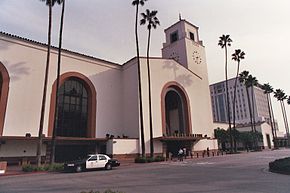Los Angeles Union Station
| Los Angeles Union Station | |
|---|---|
|
Union Station
|
|
| Data | |
| Design | Terminus |
| Platform tracks | 12 |
| abbreviation | LAX |
| opening | 1939 |
| Architectural data | |
| Architectural style | Spanish colonial style, Mission Revival and late Art Deco |
| architect | John Parkinson and Donald B. Parkinson |
| location | |
| City / municipality | los Angeles |
| State | California |
| Country | United States |
| Coordinates | 34 ° 3 ′ 21 ″ N , 118 ° 14 ′ 3 ″ W |
| List of train stations in the United States | |
Union Station , which opened in May 1939 , is Los Angeles' main train station and is located on the northern edge of Downtown Los Angeles . Union Station is one of the last major train stations to be built in the United States . Compared to the other Union Stations in the USA - this term refers to stations that were used jointly by several railway companies - it is quite manageable even with its large and lavishly decorated waiting room and the adjoining ticket office. It was formerly known as the Los Angeles Union Passenger Terminal (LAUPT), but the current owner, Catellus Development, renamed it Los Angeles Union Station (LAUS). Union Station is across from historic Olvera Street .
architecture
Union Station was designed by John Parkinson and his son Donald B. Parkinson , who also designed Los Angeles City Hall and whose endeavors have left their mark on many of the city's major buildings since the late 19th century. The architectural style combines Spanish colonial , Mission Revival and late Art Deco with Moorish architectural details such as the eight-pointed stars. There are patios and courtyard gardens on both sides of the waiting room . Travelers who got off the trains originally went through the southern garden. The lower part of the interior walls is covered with travertine marble and the upper part with an early form of acoustic tile. The floor in the waiting room is covered with terracotta tiles and marble in the middle (including travertine, a little unusual in the floors as it is soft). Other parts of the station's flooring are colored tiles with Aztec influences.
South of the main building is a small masterpiece, the remarkable train station restaurant, which was designed by architect Mary Colter , who works in the southwest of the USA . The pub was the last Fred Harvey Company restaurant to be built at train stations.
history
The station originally served the Atchison, Topeka and Santa Fe Railway , the Southern and Union Pacific Railroad, and the Pacific Electric Railway and the Los Angeles Railway . It replaced the railway stations of these companies located in various parts of the city and was chosen as an alternative to an elevated railway network in a referendum .
Union Station was built on what was then the Chinatown of Los Angeles. Today's Chinatown was created after the resettlement of the local businesses and residents.
During the Second World War the station was very busy, but afterwards experienced falling passenger numbers as a result of the automobile and airplane boom, and about half of the platform tracks were removed over the years. Some entrances are locked, service areas are out of order or inaccessible, e.g. B. Cash desk, luggage storage.
Today the Union Station is busy again, especially since the opening of a subway station in 1993 (see also Metro Los Angeles ), the introduction of the Metrolink local transport service and because of the ever-increasing demand for the Pacific Surfliner. The number of daily departures by the Pacific Surfliner has more than tripled since 1980.
As of August 2020, 12 tracks are in use on six platforms. Up until March 2020, 94–96 trains left there on weekdays; since then the timetable has been reduced due to the COVID-19 pandemic .
Current long-distance trains are:
- the Pacific Surfliner ( San Diego - Los Angeles - Santa Barbara - San Luis Obispo )
- the Coast Starlight to Seattle via Emeryville ( San Francisco ) and Portland
- the Texas Eagle (to San Antonio together with Sunset Limited , then to Chicago via Dallas )
- the Southwest Chief to Chicago via Albuquerque and Kansas City, Missouri and
- the Sunset Limited route to New Orleans .
Web links
Individual evidence
- ^ Juan Davis, Was the New Chinatown a Neighborhood or a Media Campaign? , KCET dated August 31, 2010.
- ↑ Metrolink Timetable Effective October 14, 2019. Metrolink , October 2019, accessed on August 18, 2020 .


